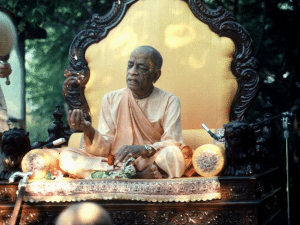Tantric view of Krishna worship...
Subal: Our wedding took place on one Saturday evening, in February 1967. Carolyn borrowed a white sari from Krishna, who lived in the commune with us and ran a Haight Street boutique. I borrowed a saffron dhoti from Hayagriva, who came from the New York temple. Saris and dhotis are traditional Indian clothes adopted by the Krishna movement. They consist of a long piece of cloth that is wrapped, pleated, and draped in men's and women's styles.
We spent the day preparing a feast. I went downtown to get rare spices, a case of milk, and ten pounds of butter so Swamiji could cook milk sweets. The temple was decorated with many flowers I picked in Golden Gate Park that morning.
There was a fire sacrifice similar to the one at the initiation. After traditional Hindu vows, instead of exchanging rings our cloths were tied together. Everyone joined in the chanting. The feast was delicious. Afterwards, everyone chanted and danced. I played the kettle drum and danced so ecstatically, it was hard to keep my poorly tied dhoti from falling off.
Krishna Devi (her new married name meaning goddess) and I went home and made love on a flower strewn bed. Even though we were only parts Krishna, we enjoyed the same pleasures he did according to late medieval Indian devotional poets such as Govinda Das and Vidyapati whom we read. I thought of Radha's jug like breasts as she straddled Krishna making love to him as Krishna Devi straddled me while I fondled her breasts. We are different in quantity from God, but similar in quality. According to scripture, Krishna took 16,108 wives when he was on earth five thousand years ago. I had one.
Contrary to Swamiji’s teachings, I began my devotion to Radha Krishna with a tantric view of sexuality and spirituality. It stuck with me over the years.
